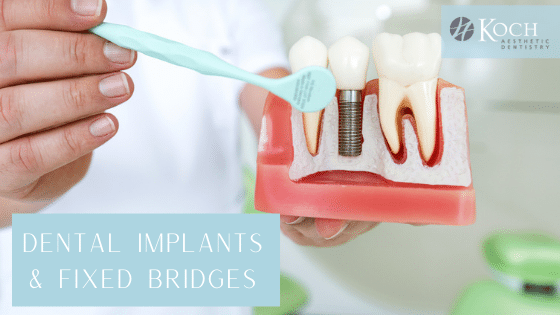
24 Sep Dental Implants & Fixed Bridges – What You Need to Know
Tooth loss is more common than you may think. Nearly 69% of adults lose at least one adult tooth between the ages of 35-44. And by the time they reach 74, almost a quarter of Americans will lose all their teeth. Luckily, with current dental advancements, there are many options for addressing lost teeth. We previously discussed the importance of replacing lost teeth. Now we will break down the two most popular options for lost tooth replacement: dental implants and fixed bridges.
What Are Dental Implants?
The underlying structure of a tooth includes bone, ligaments, and nerves. When you lose a tooth, this structure is removed, and the surrounding areas can begin to deteriorate. A dental implant replaces the visible, above gum portion of the tooth and recreates the underlining structure with a rod (titanium or ceramic).
Your dentist will place the rod in the jawbone first. After a couple of months, the bone surrounding the implant should grow around the implanted rod, and your dentist will place a crown on top of it. Dental implants are a popular option because they can promote the healing of bone structure and gums surrounding the lost tooth.
Here are some pros and cons of getting dental implants:
Pros:
- Can last 15 years or more
- Will retain natural appearance longer than bridges
- Will not damage healthy teeth around the implant
- Will promote bone regeneration and strengthen the area underneath the missing tooth
Cons:
- Is not likely to be covered by insurance
- Lengthy installment process (can take up to 6 months)
- More expensive than bridges
- May lead to surgical complications
What Are Fixed Dentures?
A fixed dental bridge attaches to the healthy teeth on either side of the gap where the missing tooth once was. Ordinarily, the two teeth on either side of the gap are shaved down, and a bridge is cemented into place, using the two shaved down teeth as posts. The bridge consists of two crowns placed on shaved down teeth and a crown that is attached to them and placed in the gap.
Depending on your particular circumstances, Dr. Koch may place a Maryland bridge to cover the gap. A Maryland bridge is a winged bridge embedded into the neighboring teeth instead of fully capping them.
Pros:
- Is most likely covered by insurance
- Does not require bone grafting or invasive surgery
- Lower cost
- Installation is usually done in 2 visits a few weeks apart.
Cons:
- Has to be replaced every 5-7 years
- Loses natural-looking appearance with age
- Causes more cavities and tooth decay in surrounding teeth than dental implants
- Could damage the healthy teeth surrounding the missing tooth
Dental Implants vs. Fixed Bridges
Whether you choose to go with dental implants or fixed bridges to replace a missing tooth will depend on your specific situation. Dr. Koch will advise you on which option might be best for you. In addition, it can be helpful to consider the following points:
- Cost
- Number of missing teeth
- Time
- Your overall health
If you have any questions or would like advice on which option is right for you, we are always here to help!
Koch Aesthetic Dentistry in Birmingham, Alabama
Replacing a lost tooth is necessary for both your oral health and aesthetic purposes. When it comes to tooth replacement, Dr. Koch can help you choose which option suits you better and answer any questions you may have. Please contact us today if you’d like to learn more about our dental implants or fixed bridges.


